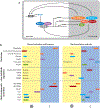Time-Restricted Eating to Prevent and Manage Chronic Metabolic Diseases
- PMID: 31180809
- PMCID: PMC6703924
- DOI: 10.1146/annurev-nutr-082018-124320
Time-Restricted Eating to Prevent and Manage Chronic Metabolic Diseases
Abstract
Molecular clocks are present in almost every cell to anticipate daily recurring and predictable changes, such as rhythmic nutrient availability, and to adapt cellular functions accordingly. At the same time, nutrient-sensing pathways can respond to acute nutrient imbalance and modulate and orient metabolism so cells can adapt optimally to a declining or increasing availability of nutrients. Organismal circadian rhythms are coordinated by behavioral rhythms such as activity-rest and feeding-fasting cycles to temporally orchestrate a sequence of physiological processes to optimize metabolism. Basic research in circadian rhythms has largely focused on the functioning of the self-sustaining molecular circadian oscillator, while research in nutrition science has yielded insights into physiological responses to caloric deprivation or to specific macronutrients. Integration of these two fields into actionable new concepts in the timing of food intake has led to the emerging practice of time-restricted eating. In this paradigm, daily caloric intake is restricted to a consistent window of 8-12 h. This paradigm has pervasive benefits on multiple organ systems.
Keywords: circadian rhythms; metabolic disease; time-restricted eating; time-restricted feeding.
Figures



References
-
- Akerstedt T, Knutsson A, Alfredsson L, Theorell T. 1984. Shift work and cardiovascular disease. Scand.J. Work Environ. Health 10:409–14 - PubMed
Publication types
MeSH terms
Grants and funding
LinkOut - more resources
Full Text Sources
Other Literature Sources
Medical

